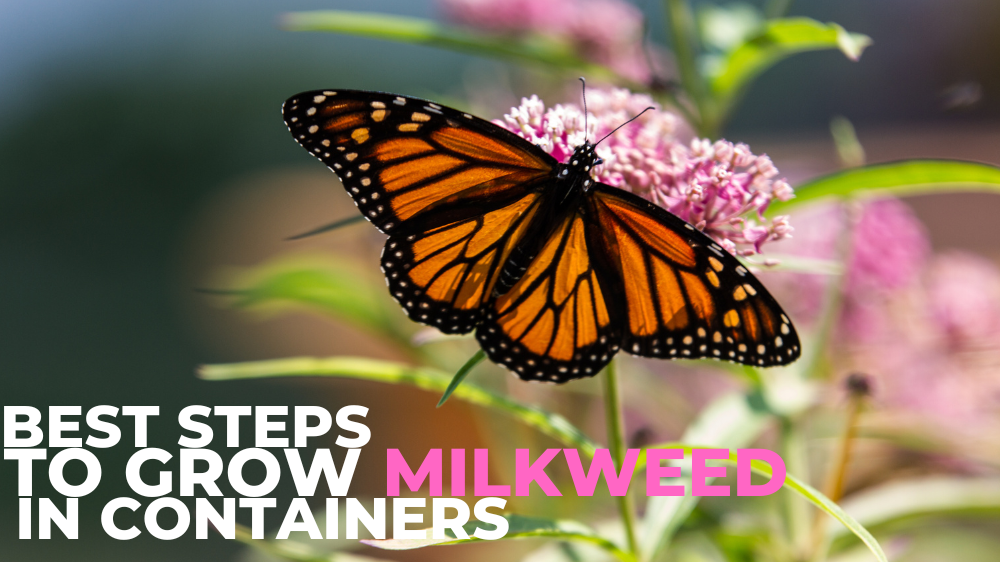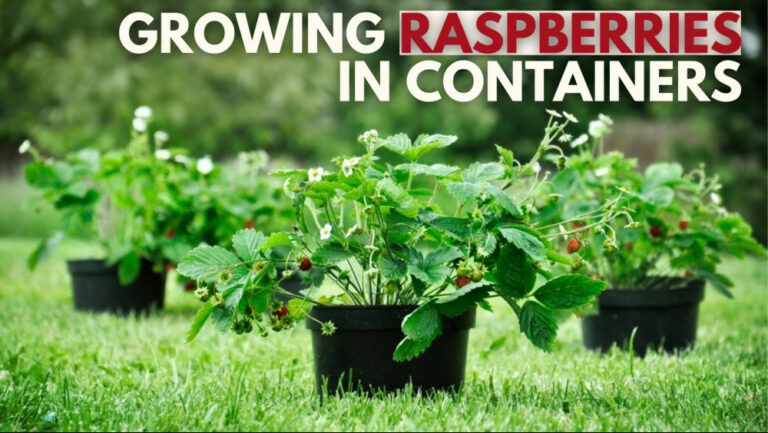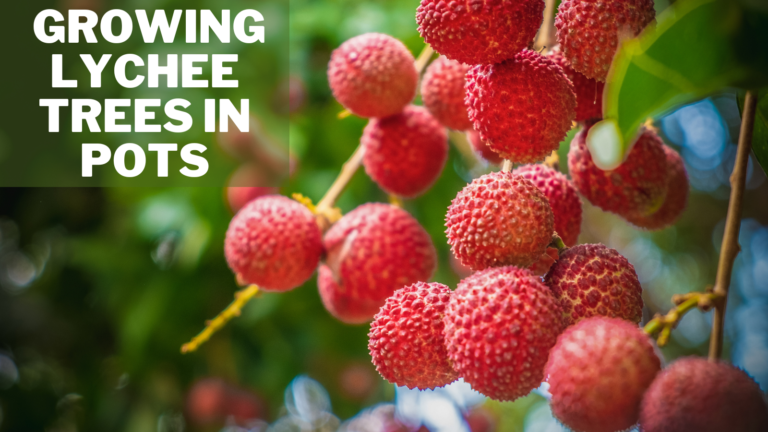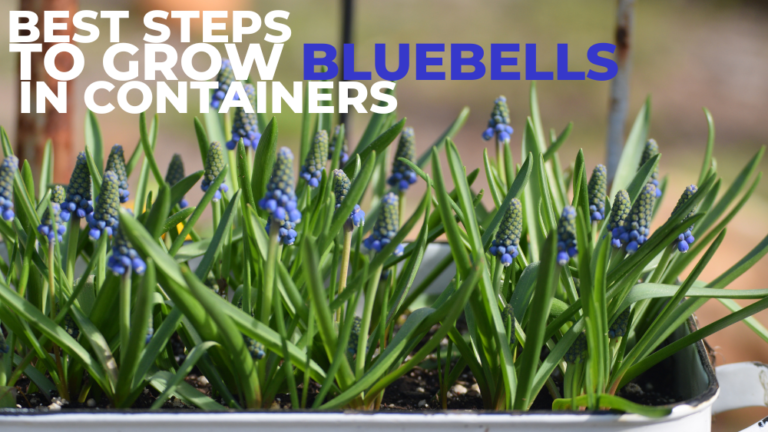Best Steps To Grow Milkweed In Containers
Best Steps To Grow Milkweed In Containers
We all like seeing Monarch butterflies darting in our flowerbeds, so we want plants to draw them in and make them want to come again.
We might think about growing milkweed in a pot as it is sometimes viewed as an unwelcome plant in the landscape. I’ll share some essential steps to grow milkweed in containers in this blog.
History And Origin Of Milkweed
Native Americans used native to North America, milkweed plants for various purposes, including food, medicine, and other items.
Like spinach or kale, milkweed leaves were cooked or stewed as food. Green blooms from it were picked and steamed like broccoli.
Milkweed plants must be prepared before consumption because they have a low toxicity level when consumed raw.
Native Americans showed European settlers how to prepare milkweed plants for appropriate consumption before they arrived in the New World.
It is crucial to remember not to wipe your eyes while handling milkweed since the sap can irritate them.
Beta-carotene and vitamin C levels in milkweed are high. Milkweed sap was applied topically to cure ringworm, warts, wounds, burns, and insect bites.
It has also been said that milkweed sap can increase breastfeeding in nursing mothers.
To treat conditions like coughs, bronchitis, colds, typhoid fever, asthma, arthritis, PMS, and worms and to calm the nerves, milkweed roots and leaves were brewed into a potent infusion.
0 of one minute and twenty seconds 0% volume 00:02 01:20. However, the history of milkweed plants suggests other applications.
It has been discovered that the white, silky fluff linked to milkweed seeds is five times warmer than wool and six times more buoyant than cork.
This fluff was used to line winter garments, footwear, and stuff pillows and mattresses. Additionally, the fluff was spun into a cozy, wool-like yarn.
Life jackets were stuffed with milkweed seed fluff during World War II. Native Americans also used pod fluff as fuel, making thread and rope out of the tough, stringy stems.
Milkweed has recently been investigated for usage as a paper, fossil fuel, and rubber alternative. Researchers are also using milkweed seeds to create organic nematode controls.
Types Of Milkweed
Flowers are typically selected for gardens based on colour, maintenance requirements, or other physical characteristics.
Asclepias spp. Milkweeds (the only plant that the monarch caterpillar, which eventually turns into the imperilled monarch butterfly, can consume) are relatively unique.
Monarchs won't exist if there isn't milkweed. Many milkweed plants are currently planted in butterfly and pollinator gardens. To grow milkweed in containers, you should know the best varieties.
1. Butterfly Weed (Asclepias tuberosa)
Butterfly weed is covered in vibrantly coloured blossoms. While some cultivars have brilliant orange or red blooms, many have yellow blossoms. Flat tips can be seen on the flower clusters.
This small cultivar grows to a height of only 2 feet. It tolerates drought and requires full sun and soil with good drainage.
The plant can bloom from May through September, so deadhead it frequently to encourage more blooming.
2. Common Milkweed (Asclepias syriaca)
Butterfly weed is shorter than common milkweed, with taller stalks that typically reach 5 feet but can occasionally reach as high as 8 feet.
Only in the summer can balls of tiny pink to purple flowers appear. This type should be placed away from regions that receive shade because it requires a lot of sunlight and slightly moist soil.
3. Showy Milkweed (Asclepias speciosa)
For the Western half of North America, summer brings about the blooming of star-shaped flower clusters that are ball-shaped and typically blush or rosy pink.
This is another sun-loving plant that requires water. It is pretty brief, with plants only reaching 3 to 4 feet, with a few reaching 6 feet.
4. Swamp Milkweed (Asclepias incarnata)
This type, which can tolerate greater shade, requires a lot of hydration and typically moist soil.
Between early summer and mid-autumn, tight clusters of pink flowers with hues ranging from pale to hot bloom. There are moments when the blooms smell like vanilla. The plant has a 5-foot height limit.
5. Texas Milkweed (Asclepias texana)
It grows at higher altitudes in western and southwestern Texas, particularly in the Trans-Pecos and Edwards Plateau regions.
This is the state's sole white milkweed species. Although it doesn't require much water, it prefers moister environments like river banks, so if your yard is close to a stream, this can be a fantastic choice. It does require full sun and somewhat acidic, well-draining soil.
6. Tropical Milkweed (Asclepias curassavica)
The tropical milkweed is a lovely plant with slender leaves and vibrant red and yellow blossoms.
It is elementary to grow and maintain, and in some parts of western California and southern Texas, it has established itself as a native species. In truth, butterflies are drawn to it and feed on it.
Ophryocystis elektroscirrha is a parasite that can live on plants. The parasite, known as OE, can attach to mature monarch butterflies and spread to the plants they visit to eat.
Caterpillars consume many parasites since tropical milkweed doesn't die in winter in these warmer regions. Therefore, the parasite doesn't perish with the plant.
7. Antelopehorn Milkweed (Asclepias viridis)
In addition to “antelopehorn milkweed,” “spider antelopehorns,” “green-flowered milkweed,” and “spider milkweed,” A. asperula also goes by these names.
This species is indigenous to the southwestern and south-central United States, including Texas, Oklahoma, Kansas, Nebraska, New Mexico, Colorado, Arizona, Utah, Idaho, California, and Nevada.
In Zones 7 to 9, antelope horns are resilient.
This plant's stems can grow upright or sprawlingly, one to two feet long. The long, narrow leaves are frequently folded in half. If you like green flowers, you should look closely at this collection.
This species' greenish-yellow and maroon-tinged, ball-shaped inflorescences bloom from April to June.
Once established, A. asperula requires very little water. In the wild, it frequently flourishes in arid regions.
Sand, clay, caliche, and loam are among the well-drained soil types it prefers and needs full sun to grow.
Grow Milkweed In Containers
Some people find that growing milkweed in pots is the best growth technique. After wintering inside a structure or garage, container-grown milkweed can be brought back outside in the spring.
The information recommends placing potted milkweeds and nectar-rich flowers in the same container to provide nutrition for the Monarch and other butterflies.
Locate them next to a seated area so you can enjoy them the most. This encourages them to return to the area where the containers are.
1. Choose The Right Container To Grow Milkweed
Select a pot at least 18′′ deep because perennial species, such as milkweed and nectar plants, have more extended root systems and require space to flourish.
Perennial plants can overwinter more successfully in larger pots because they offer excellent protection from the cold. Pick containers with good drainage.
2. Best Time To Grow Milkweed
Want to know when milkweed seeds should be planted or when to sow milkweed in pots? Seeds and plants can be planted in the spring or fall. Give milkweed enough time to develop before winter if you plant it in the fall.
The plants are adapted to fall seeding because they will naturally self-seed. In actuality, the cold and moisture of winter aid in loosening the seed coverings, allowing for spring germination.
If you would rather plant seeds in the spring, you must use cold stratification to induce dormancy by simulating these winter conditions.
3. Soil To Grow Milkweed In Containers
While container-grown plants require rich, healthy soil, milkweed plants can tolerate poor soil.
The soil's organic solid content encourages long-term growth. Potted plants require frequent watering, which washes away the soil's nutrients.
Rich soil will promote more significant growth. Top-dress the soil with organic mulch or compost or re-pot with rich potting soil every year.
4. Sunlight Requirements To Grow Milkweed
Most milkweeds need direct sunlight (at least 6 to 8 hours a day). Because they often self-seed, place your plants in an area of the garden where you can better manage their unchecked growth, like a corner or the back of a border.
5. Watering Milkweed Plants
Milkweed plants should have a light daily watering, ideally in the morning, until their roots are well-established.
Once planted, milkweed doesn't require irrigation unless there is a drought or the area is arid. When watering is necessary, water slowly and deeply to a depth of 1 to 2 inches; before watering again, wait until the top inch of soil is dry because over-watering can result in a fatal fungus.
Some milkweed cultivars, like butterfly weed, favour drier environments and hardly ever need any watering.
Some varieties, like swamp milkweed, need damp soil. You can accommodate this species with regular irrigation if your land is dry.
6. Planting Milkweed
Milkweed can be grown from seeds or sprouts. Spreading seeds directly in the garden is recommended for some types, like butterfly weeds, as they don't transplant well.
Plant Milkweed Seeds As Follows
- Choose a bed that has been tilled or raked to a fine consistency with clump-free soil.
- Don't cover the seeds. Compact them into the soil.
- Keep the soil moist until the seedlings are established.
- If planted too closely together, thin them out as they grow.
Plant Milkweed Seedlings As Follows
- Make a hole twice as deep and wide as the plant's root ball. Adjust the dirt as needed.
- To promote growth, gently separate the roots.
- The top of the root ball should be planted to level with the soil line.
- Backfill the soil surrounding the plant to remove air pockets and press the earth down.
- Water wisely.
7. Fertilizing Milkweed Plants
Fertilizing is not necessary for milkweed. Being a native plant, it may survive on poor soil. Cultivating tropical milkweed (particularly with nitrogen) raises the levels of toxic cardenolides, which can slow or kill monarch caterpillars, according to University of Michigan researchers.
However, the effects of fertilizer don't seem to be the same for perennial milkweed cultivars.
8. Pruning Milkweed Plants
Milkweed doesn't require pruning. To ensure spring growth, you may wish to trim it back to the ground, where it grows as an annual plant.
Fallen perennial plants can be pruned in late winter to early spring. When you notice new basal growth, cut the old stems back to 6 inches from the ground.
While not necessary for survival, deadheading can promote additional blooms. If you don't want your milkweed patch to grow too large, it can also stop it from self-seeding.
When pruning or deadheading milkweed, use gloves and eye protection because the sap can irritate people.
9. Propagating Milkweed Plants
Milkweed can be cultivated from seeds, stems, rhizomes or root cuttings. The best time to propagate milkweed is when the plant is dormant, in the late fall or early spring.
- Digging rhizomes from milkweed can be challenging due to the plant's thick taproots. It is frequently simpler to take cuttings off the stem. Take these actions:
- Cut 4-inch-long stems with at least three to five leaf nodes with a clean, sharp knife or gardening tool.
- Remove the lower leaves, then apply rooting hormone to the stems' undersides.
- Put stems in an 80/20 potting mixture of peat moss and perlite.
- For six to ten weeks, moisten the soil and set the pots in an excellent location away from the sun.
10. Winter Care Of Milkweed
The growth of native milkweed, a herbaceous perennial, can be pruned back in the fall.
The container should be moved to a safe location, such as a shed, garage, or basement, to shield the roots from the bitter winter temperature.
In warm climates, tropical milkweed will continue to grow, but controlling the growth is good for monarch butterfly populations.
11. Harvesting Milkweed Seeds
The common milkweed seeds are readily available plants that produce large pods with hundreds of seeds. However, it would be best if you only harvest seeds from ripe pods.
Applying light pressure will determine their ripeness rather than pulling them off the plant. They are ripe if they split along the seam.
If the pod breaks easily, use your fingers to peel it open so you can scoop out the seeds and silk. If the seeds are ripe, they will be brown.
Milkweed bug-infested pods should not be harvested; some pods should be left on the plants to promote spontaneous regrowth.
12. Pests & Diseases Of Milkweed
Milkweed is primarily unaffected by any harmful pests or illnesses.
The leaves and seed pods are occasionally consumed by insects immune to the plant's toxins, including aphids, whiteflies, scales, spider mites, thrips, and milkweed bugs.
Thankfully, they generally only inflict minor harm. But you can typically rinse them off with water. Be cautious to avoid knocking over monarch egg colonies affixed to leaf undersides.
Although young milkweed plants may be preyed upon by snails and slugs, monarch butterflies won't be harmed by whatever snail bait you employ.
The fungus may become a problem if milkweed plants are kept excessively damp. In the meantime, avoid overwatering milkweed because root rot, verticillium wilt, and leaf spot can all kill a plant and are frequently challenging to get rid of.
How To Store Milkweed Seeds
You won't have healthy seeds for planting if you pluck pods and open them to find light brown (or white!)
The fluffy mass makes it unpleasant to separate the seeds after the pods have broken open, though! So, what should a milkweed grower do?
1. Don’t Pick Pods Before Their Time
To prevent milkweed pods from breaking open, lightly attach these everyday objects around the plant.
When the pods begin to split open, keep an eye on them to know when to cut them off and bring them inside. You can also press each pod's seam to check if it begins to pop.
2. Use Rubber Bands Or Twist Ties
The seeds were simple to remove because all the fluff (coma) was matted down. The seeds should remain in the basin until completely dry.
This method works nicely when plucking a few pods at once. If you have a large quantity of pods, let the pods and seeds dry entirely before separating them.
3. Wash Or Spray Pods With Water
Sometimes, the fluff from a pod you want to collect may have already begun to emerge. Put some coins, seeds, ds and fluff in a paper bag. Then shake.
The coins facilitate seed separation. The seeds should then be shaken out by making a tiny hole in one of the bag's bottom corners.
4. Harvest Milkweed Seeds Without The Fluff – Part 1
The seeds were simple to remove because all the fluff (coma) was matted down. The seeds should remain in the basin until completely dry.
This method works nicely when plucking a few pods at once. If you have a large quantity of them, let the pods and seeds dry completely before separating them.
5. Harvest Milkweed Seeds Without The Fluff – Part 2
Did you overlook sorting the seeds after harvesting? The fluff may still be separated within without creating a mess. Place a few pennies and the seed pods' contents inside of a paper bag.
Shake after sealing the bag. The pennies will aid in the seed separation. After giving the bag a good shake, poke a small hole in the corner, and the seeds should begin to spill out. Add more shaking if required.
Conclusion
In addition to its many other uses, common milkweed has a long history as a natural remedy. Additionally, milkweed is a food source for our stunning monarch butterflies.
Discover this surprisingly practical native plant. Don’t miss adding this helpful plant to your small garden; feel free to message us if you need help growing milkweed in containers.
I trust you enjoyed this article on the Best Steps To Grow Milkweed In Containers. Please stay tuned for more blog posts soon. Take care!
JeannetteZ
>>>Please click here to read my all-inclusive article, About The Essential Companion Planting Guide<<<
>>>Please click here to read my all-inclusive article about Container Gardening<<<
>>>Are you interested in homegrown herbs and medicine? Please click here to find out more about it!<<<
Your Opinion Is Important To Me
Do you have thoughts, ideas, or questions? I would love to hear from you. Please leave me your questions, experiences, and remarks about this article on the Best Steps To Grow Milkweed In Containers in the comments section below. You can also email me at Jeannette@Close-To-Nature.org.
Disclosure
This post may contain affiliate links. I earn from qualifying purchases as an Amazon Associate and other affiliate programs. Please read my full affiliate disclosure.
You might also enjoy these blog posts:
Best Steps To Grow Bluebells In Containers
Best Steps To Grow Flax In Containers
Best Steps To Grow Cauliflower In Containers
Best Steps To Grow Lentils In Containers
Best Steps To Grow Zucchini In Containers





















